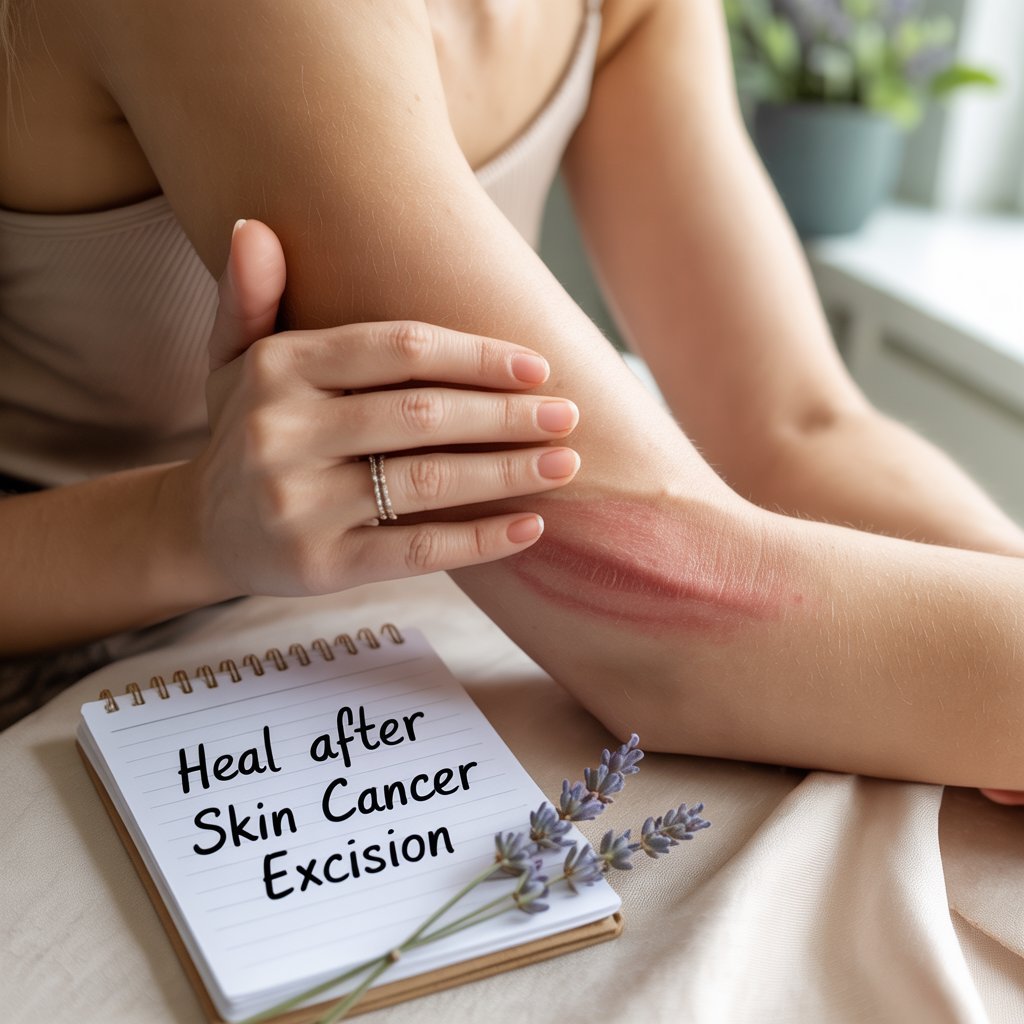Understanding Skin Cancer Excision
Skin cancer excision is the surgical removal of a tumor plus a margin of healthy tissue—standard excision being a common dermatologic surgery care technique.
Mohs surgery uses layer‑by‑layer removal with microscopic checks for clean margins, ideal for high‑risk sensitive areas. Both aim to prevent recurrence and support skin cancer treatment recovery.
As a board-certified dermatology clinician who has performed and overseen numerous skin cancer surgeries, I’ve seen how understanding the excision process empowers patients and supports better recovery outcomes. Knowing

what to expect after skin cancer surgery helps patients manage their recovery timeline. Early post‑operative care, including gentle wound care, suture care, and monitoring for infection, sets the stage for effective healing.
Immediate Post-Op Wound Care
During the first 24–48 hours, keep the wound covered with a sterile dressing to prevent infection. Gently clean the area twice daily with mild soap and water or saline solution, avoiding hydrogen peroxide, alcohol, and antiseptic cleansers that can slow healing.
Apply a thin layer of petroleum jelly to maintain moisture and reduce scarring risk. Change nonstick bandages at least once daily, monitoring for signs of infection such as redness, swelling, or discharge.
In our dermatology practice, we educate patients to use sterile technique and avoid aggressive cleaning agents that damage regenerating tissue. Using a Q-tip or gauze pad protects delicate skin and helps ensure the best possible cosmetic result. These steps support a smooth recovery and reduce the risk of complications.
Signs of Normal Healing vs. Infection
In the first week after surgery, expect mild swelling, pinkish drainage, and scabbing—signs that new tissue is forming. Pink, bumpy granulation tissue and itching also indicate healing. Warning signs of infection include yellow discharge, worsening redness, heat, foul odor, or fever.
As someone who’s managed hundreds of post-op wounds, I always emphasize early detection. Recognizing the difference between normal healing and infection is essential for timely intervention.
Patients who track their symptoms and stay in touch with their care team often recover more quickly and avoid setbacks.
Pain Management After Excision
Mild discomfort is common. Over-the-counter options like acetaminophen or ibuprofen usually suffice, though some may receive prescription pain relief. Cold compresses, gentle pressure, and saline-soaked gauze can relieve localized tenderness.

I always remind patients: Pain should improve each day—not worsen. If discomfort escalates or lingers past a week, contact your provider. Proactive pain management not only improves comfort but also helps you stay consistent with wound care.
Stitches, Staples, and Suture Removal
Non-dissolvable stitches are typically removed after 10–14 days. Dissolvable sutures fade within 2–4 weeks. Your provider will assess healing and guide your next steps.
Removing stitches isn’t just about timing—it’s about clinical judgment. In our clinic, we evaluate the wound’s strength, moisture balance, and absence of infection before proceeding. That’s how we avoid premature removal and promote optimal scar formation.
Scar Management & Aesthetic Recovery
Use petroleum jelly under a nonstick dressing while the wound is healing. After closure, apply silicone gel or sheets, massage the scar, and protect with SPF 30+.
As a clinician focused on both health and aesthetics, I’ve seen dramatic improvements when patients start scar therapy early and stick to it consistently. Scars can fade significantly over 6–12 months with the right routine.
Lifestyle Adjustments During Recovery
Showering is safe after 24 hours, but avoid soaking the wound. Hold off on intense physical activity until stitches are removed. Light walking is encouraged for circulation.
We routinely tailor return-to-activity plans based on excision size, location, and occupation. A patient’s job, fitness habits, and personal risk factors all shape the ideal recovery schedule.
Nutrition & Hydration for Optimal Healing
Eat protein-rich foods (chicken, eggs, fish, legumes), and vitamin-rich fruits and veggies. Stay hydrated with water, broths, and non-alcoholic fluids.
From clinical experience, patients who follow a nutrient-dense diet tend to heal faster and experience fewer complications. I often provide dietary recommendations alongside wound care instructions for complete recovery support.
Mental Health and Emotional Well-being
Feeling anxious or self-conscious is common after surgery. Talk to loved ones or a counselor. Try meditation, walking, or journaling. Join a support group.
Over the years, I’ve found that emotional healing is just as important as physical recovery. We encourage patients to address body image concerns and mental well-being throughout the healing journey.
Sun Protection After Surgery
Use SPF 30+ daily after the incision closes. Wear hats, UPF clothing, and avoid midday sun. Reapply sunscreen after swimming or sweating.

Sun protection isn’t optional—it’s part of your treatment plan. We educate every patient about UV damage and scar hyperpigmentation during the recovery phase to prevent further skin cancer.
When to Call Your Dermatologist
Reach out if you notice worsening pain, redness, pus, a foul odor, fever, or if bleeding persists longer than 20 minutes. Stay in close contact if you have questions about your wound, timeline, or symptoms.
We always prefer early calls rather than delayed ones. Timely communication prevents complications and improves long-term results.
FAQs About Healing After Skin Cancer Excision
How long does it take to heal from skin cancer surgery?
Most wounds heal substantially within 4–6 weeks. Scar remodeling may take 12–18 months.
Will I have a scar after excision?
Yes, but consistent scar care and sun protection can dramatically minimize appearance over time.
Can I wear makeup on the healing site?
Only after full closure—usually 1–2 weeks. Applying too early may delay healing.
When can I resume exercise after surgery?
Avoid strenuous activity until stitches are removed and cleared by your provider.
Should I cover my scar after skin cancer surgery?
Yes—use a nonstick dressing and sunscreen to protect and optimize healing.

